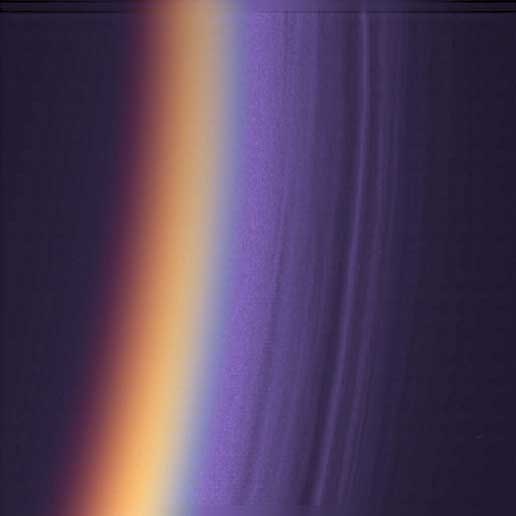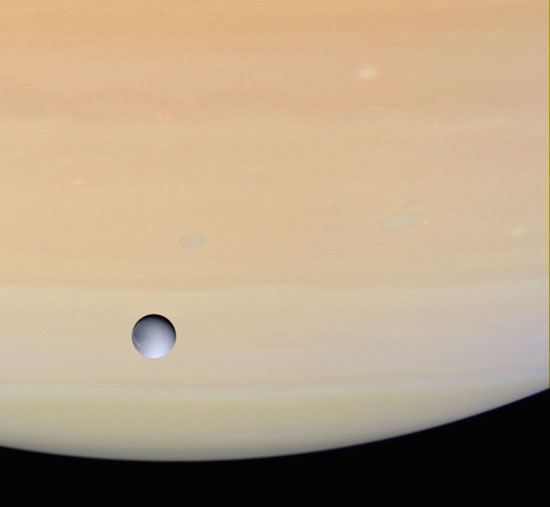Geotimes

Untitled Document

Web Extra
Friday, December 17, 2004
A Saturnian one-two punch:
Flybys of Titan and Dione
 On Monday, the Cassini-Huygens
spacecraft flew by Titan only 1,200 kilometers above the moon's surface. It
was the second such flyby of Titan, Saturn's largest moon, since the spacecraft
began orbiting Saturn on June 30. Then on Tuesday, Cassini-Huygens flew by Dione,
another of Saturn's moons, at 82,000 kilometers, providing the closest glimpse
ever of its enticing surface.
On Monday, the Cassini-Huygens
spacecraft flew by Titan only 1,200 kilometers above the moon's surface. It
was the second such flyby of Titan, Saturn's largest moon, since the spacecraft
began orbiting Saturn on June 30. Then on Tuesday, Cassini-Huygens flew by Dione,
another of Saturn's moons, at 82,000 kilometers, providing the closest glimpse
ever of its enticing surface.
"We're very excited," said Dennis Matson, project scientist on the
Cassini-Huygens mission at NASA's Jet Propulsion Laboratory (JPL) at Caltech
in Pasadena, Calif., during a presentation at the fall meeting of the American
Geophysical Union (AGU) in San Francisco on Tuesday. Both of these flybys have
provided Earth-bound scientists with new data, images and surprises, as they
eagerly await the Huygens descent through Titan's atmosphere beginning on Christmas
Eve.
Layers of haze compose Titan's upper atmosphere,
photographed in ultraviolet by Cassini and modified to appear in true color.
Images of Titan from Monday's flyby and of Dione are posted on the Jet
Propulsion Lab (JPL) Web site. Courtesy
NASA/JPL.
Scientists say that Titan, which is larger than Mercury and Pluto, is one of
the most likely places in our solar system to find extraterrestrial life, as
it is the only known body to have an atmosphere. And Monday's flyby has confirmed
what atmospheric models had predicted, and revealed some new surprises about
the moon's murky orange skies and topographic features since the spacecraft's
last flyby on Oct. 26, said Linda Spilker of JPL, deputy Cassini-Huygens project
scientist, at a press conference on Thursday.
One of those surprises, said Kevin Baines, a Cassini Science Team member, was
that the clouds that had been observed by the previous flyby had moved, providing
the scientists with "something to study." The cloud movement is also
the first evidence of weather on Titan, Baines said. The clouds moved much more
slowly than previous images had revealed and looked to be at lower altitudes
as well. Cassini's flyby also observed multiple atmospheric layers (perhaps
as many as 12 or more), and at least one very thick one that looks as though
it is composed of hydrocarbons, Baines said.
Through the atmospheric haze, Cassini was also able to image bright circular
or spiral-shaped features, said Carolyn Porco, Cassini imaging team leader at
the Space Science Institute in Colorado. Although the scientists are excited,
they have no idea what the features are, or if they are depressions or uplifts,
Porco said at Thursday's press conference. The same was true after the October
flyby revealed what appear to be lava domes and flows.
Until they have a chance to look at the various features with synthetic aperture
radar and radar altimetry data, Porco said, the scientists won't know the 3-D
landscape — they'll just have to keep guessing about "what's high
and what's low." That opportunity may come in February or March, when scientists
will be able to use
to get a better idea of the topography.
 The topography of another
moon, Dione, is being revealed much more quickly than on Titan, especially following
this week's exciting flyby. When Voyager flew by Dione in 1980, it caught glimpses
of a "wispy terrain," which is considered the "most distinctive
feature on this satellite," Porco said. Since then, scientists believed
that the wisps were probably thick ice depositions. However, from the latest
flyby, scientists now say that thick ice deposits were not the primary feature.
Instead, the satellite is pockmarked with impact craters, and crisscrossed with
fractures and cliff faces that appear to be very deep.
The topography of another
moon, Dione, is being revealed much more quickly than on Titan, especially following
this week's exciting flyby. When Voyager flew by Dione in 1980, it caught glimpses
of a "wispy terrain," which is considered the "most distinctive
feature on this satellite," Porco said. Since then, scientists believed
that the wisps were probably thick ice depositions. However, from the latest
flyby, scientists now say that thick ice deposits were not the primary feature.
Instead, the satellite is pockmarked with impact craters, and crisscrossed with
fractures and cliff faces that appear to be very deep.
Saturn looms behind its moon Dione, photographed on Dec. 14 as Cassini approached
for a closer view. Courtesy NASA/JPL.
Those fractures and cliff faces look like wisps from far away, but the close
view provided by Cassini reveals not a thick ice deposit to be found. This is
very surprising, Porco said. Some of the team members, Porco said, suggest that
this type of complex system of fractures is what they would expect if Dione
had started out as slush and then solidified. "This has been a delightful
and surprising encounter," she said, with many more years of analysis to
come.
For the next four years of the Cassini mission, the spacecraft will fly by Titan
every month or so. Of more immediate interest, however, is the Huygens probe's
descent into Titan's atmosphere. On Dec. 24, Huygens will detach from its galactic
taxi, Cassini, and will enter Titan's atmosphere. For 21 days, the probe will
float through the atmosphere, sending images and data signals to Cassini, which
will relay the data back to Earth. Then on Jan. 14, Huygens will begin its descent
onto Titan. Three parachutes will deploy to slow the probe's landing and to
provide a stable platform for scientific measurements — very possibly the
last contact scientists will have with the probe.
The entire descent will last about two and a half hours, Matson said, "and
there's no way to guarantee where we'll land or how. We could land in water,
snow, on rock." The scientists have aimed the landing at a dark area on
the moon that they hope represents a liquid surface (perhaps water) near the
equator, based on images already taken by Cassini. Wherever it lands, he said,
there's little guarantee that Huygens will land right-side-up or that it will
survive the landing.
Regardless of whether or not the probe survives, Matson said, NASA and its partners
are hopeful that as it lands, the probe will give them even more detailed information
than it has already sent back. "The best is yet to come," he said.
Other interesting results are coming from Saturn (see sidebar)
and from the planet's other moons, including Phoebe, which Cassini zoomed by
last summer (see Geotimes Web Extra).
The close view of that satellite revealed temperatures, carbon dioxide levels,
iron content and ice content, as well as craters, Matson said.
Cassini is the fourth NASA spacecraft to explore Saturn. Pioneer 11 passed by
in 1979, Voyager in 1980 and Voyager 2 in 1981. Cassini is the first mission,
however, to orbit the planet. The Cassini-Huygens mission is a collaborative
project of NASA, the European Space Agency and the Italian Space Agency. The
Huygens probe was named after Christian Huygens, a Dutch astronomer who discovered
Titan in 1655.
Megan Sever
Saturn's
surprises
As Cassini continues to get new views of some of Saturn's more than 30 moons,
researchers have plenty of other data to analyze about the planet's composition,
its huge and complex magnetosphere, and its famous rings.
Since the spacecraft reached Saturn's orbit in July, scientists have learned
more about the composition and grain size of the planet's rings, which extend
hundreds of thousands of miles from the planet and are composed of billions
of particles of ice and rock, ranging from the size of sand grains to cars
and houses. Right now, they only understand about 5 percent of the rings,
said Jeff Cuzzi of the NASA Ames Research Center in California, but that
is changing quickly.
Cassini has imaged at least three new ringlets within the D ring that were
not there when Voyager flew by — indicating that the rings are very
dynamic and variable. Cassini has also revealed a "buried treasure"
in the mass-heavy B ring, Cuzzi said in a presentation at the annual fall
meeting of the American Geophysical Union on Tuesday: Some reddish organic
material is mixed in; most of the rings are composed of 90 percent water.
Also, he said, certain regions of the rings have proven to be very "polluted"
by meteoroid bombardment.
The rings, along with Saturn's icy satellites, may also be contributing
to the vast amount of water in Saturn's magnetosphere, which is nearly a
factor of 10 higher than the scientists had thought, said Tamas Gombosi
at the University of Michigan, who is a member of the Magnetosphere and
Plasma Science working group on the mission. Cassini imaged the planet's
magnetosphere — a magnetic envelope of charged particles that surrounds
some planets, including Earth — for the first time. The large mass
of water could have important consequences for the magnetosphere, which,
Gombosi said, is particularly interesting because it combines a number of
properties usually only seen in one source. The scientists are now trying
to figure out what breaks the water out of the rings and drags it into the
magnetosphere.
In studying Saturn, there's never a dull moment, as Dennis Matson, project
scientist on the Cassini-Huygens mission at NASA's Jet Propulsion Laboratory
(JPL) at Caltech in Pasadena, Calif., said: "Every time we think we
see something, it turns out not to be what we thought it was — we're
stumbling through and faced with the challenge of interpretation."
MS
|
Links:
NASA's
Cassini mission home page
NASA
JPL Cassini-Huygens project
"Sliding into
Saturn," Geotimes Web Extra, July 2, 2004
Back to top
Untitled Document

 On Monday, the Cassini-Huygens
spacecraft flew by Titan only 1,200 kilometers above the moon's surface. It
was the second such flyby of Titan, Saturn's largest moon, since the spacecraft
began orbiting Saturn on June 30. Then on Tuesday, Cassini-Huygens flew by Dione,
another of Saturn's moons, at 82,000 kilometers, providing the closest glimpse
ever of its enticing surface.
On Monday, the Cassini-Huygens
spacecraft flew by Titan only 1,200 kilometers above the moon's surface. It
was the second such flyby of Titan, Saturn's largest moon, since the spacecraft
began orbiting Saturn on June 30. Then on Tuesday, Cassini-Huygens flew by Dione,
another of Saturn's moons, at 82,000 kilometers, providing the closest glimpse
ever of its enticing surface.
 The topography of another
moon, Dione, is being revealed much more quickly than on Titan, especially following
this week's exciting flyby. When Voyager flew by Dione in 1980, it caught glimpses
of a "wispy terrain," which is considered the "most distinctive
feature on this satellite," Porco said. Since then, scientists believed
that the wisps were probably thick ice depositions. However, from the latest
flyby, scientists now say that thick ice deposits were not the primary feature.
Instead, the satellite is pockmarked with impact craters, and crisscrossed with
fractures and cliff faces that appear to be very deep.
The topography of another
moon, Dione, is being revealed much more quickly than on Titan, especially following
this week's exciting flyby. When Voyager flew by Dione in 1980, it caught glimpses
of a "wispy terrain," which is considered the "most distinctive
feature on this satellite," Porco said. Since then, scientists believed
that the wisps were probably thick ice depositions. However, from the latest
flyby, scientists now say that thick ice deposits were not the primary feature.
Instead, the satellite is pockmarked with impact craters, and crisscrossed with
fractures and cliff faces that appear to be very deep. 